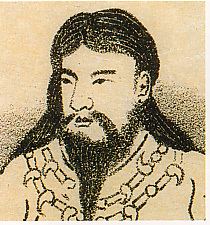Died 98 BC Children Emperor Sujin | Successor Sujin Parents Emperor Kōgen | |
 | ||
Reign 158 BC – 98 BC (traditional) Burial Kasuga no Izakawa no sak no e no misasagi (Nara) Similar | ||
Emperor Kaika (開化天皇, Kaika-tennō); also known as Wakayamatonekohikooobi no Mikoto; is the ninth emperor of Japan, according to the traditional order of succession.
Contents
No firm dates can be assigned to this emperor's life or reign; he is conventionally considered to have reigned from 157 BC to 98 BC. He may have lived in the early 1st century.
Legendary narrative
Modern scholars have come to question the existence of at least the first nine emperors; Kaika's son Emperor Sujin is the first that many agree might have actually existed, in the third or fourth century. The name Kaika-tennō was assigned to him posthumously by later generations.
Kaika is regarded by historians as a "legendary emperor", and there is a paucity of information about him. There is insufficient material for further verification and study. The reign of Emperor Kinmei (c. 509 – 571 AD), the 29th emperor, is the first for which contemporary historiography is able to assign verifiable dates; However, the conventionally accepted names and dates of the early emperors were not to be confirmed as "traditional" until the reign of Emperor Kanmu (737–806), the 50th sovereign of the Yamato dynasty.
In the Kojiki and Nihonshoki, only his name and genealogy were recorded. The Japanese have traditionally accepted this sovereign's historical existence, and an Imperial misasagi or tomb for Kaika is maintained; however, no extant contemporary records have been discovered that confirm a view that this historical figure reigned. He was the eighth of eight emperors without specific legends associated with them, also known as the "eight undocumented monarchs" (欠史八代,, Kesshi-hachidai).
Jien records that Kaika was the second son of Emperor Kōgen and that he ruled from the palace of Isakawa-no-miya at Kasuga in what came to be known as Yamato Province.
Kaika is a posthumous name. It is undisputed that this identification is Chinese in form and Buddhist in implication, which suggests that the name must have been regularized centuries after the lifetime ascribed to Kaika, possibly during the time in which legends about the origins of the Yamato dynasty were compiled as the chronicles known today as the Kojiki.
The site of Kaika's grave is not known. This emperor is traditionally venerated at a memorial Shinto shrine (misasagi) in Nara. The Imperial Household Agency designates this location as Kaika's mausoleum. It is formally named Kasuga no Izakawa no sak no e no misasagi.
Consorts and children
Empress: Ikagashikome (伊香色謎命), daughter of Oohesoki (大綜麻杵)
Taniwa no Takanohime (丹波竹野媛), daughter of Taniwa no Ooagatanushi Yugori (丹波大県主由碁理)
Hahatsuhime (姥津媛), younger sister of Washihime
Washihime (鸇比売), daughter of katsuragi no Tarumi no Sukune (葛城垂見宿禰)
